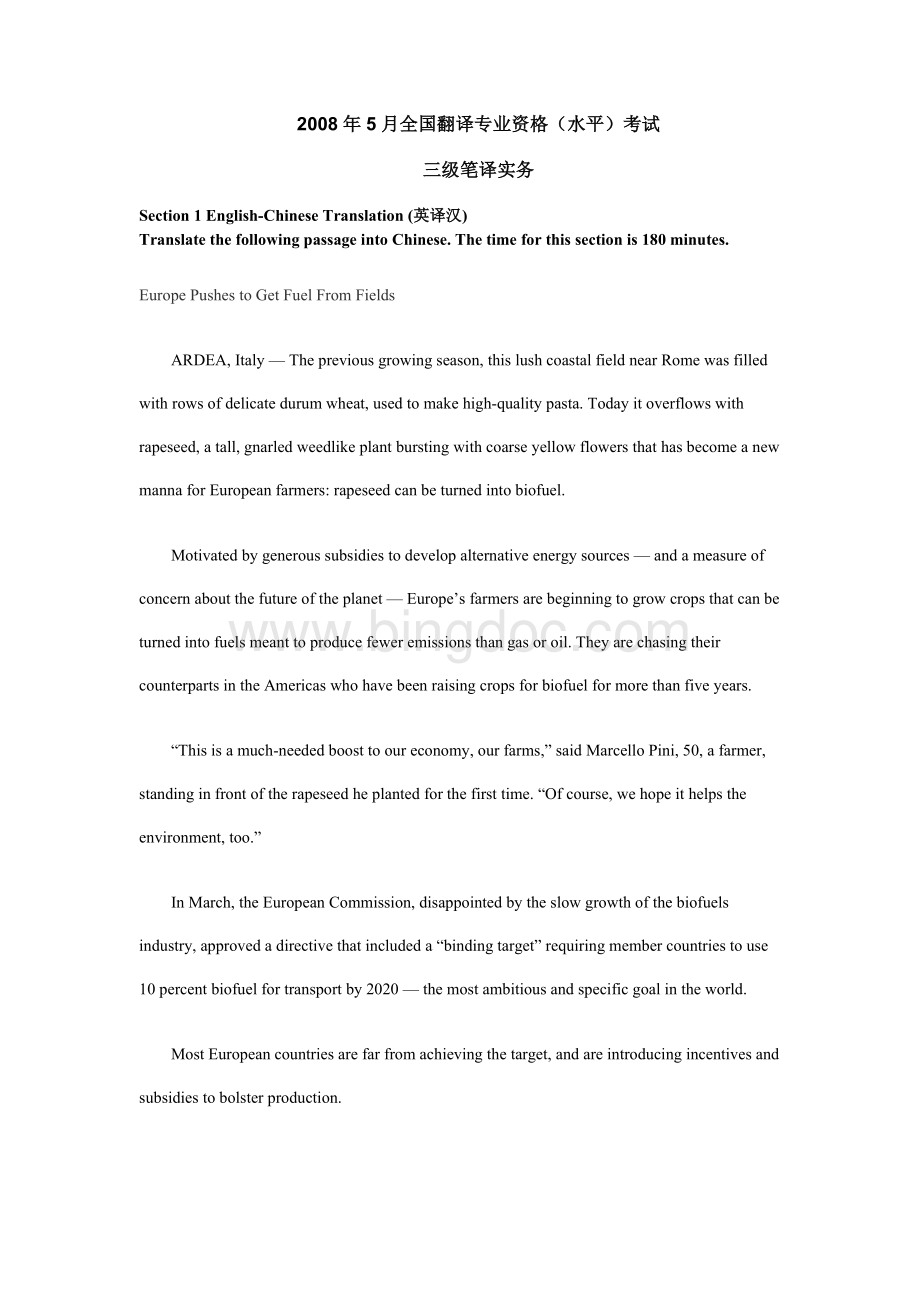2008年05月CATTI三级笔译实务真题(英译汉部分、附答案).doc
《2008年05月CATTI三级笔译实务真题(英译汉部分、附答案).doc》由会员分享,可在线阅读,更多相关《2008年05月CATTI三级笔译实务真题(英译汉部分、附答案).doc(7页珍藏版)》请在冰点文库上搜索。

2008年5月全国翻译专业资格(水平)考试
三级笔译实务
Section1English-ChineseTranslation(英译汉)
TranslatethefollowingpassageintoChinese.Thetimeforthissectionis180minutes.
EuropePushestoGetFuelFromFields
ARDEA,Italy—Thepreviousgrowingseason,thislushcoastalfieldnearRomewasfilledwithrowsofdelicatedurumwheat,usedtomakehigh-qualitypasta.Todayitoverflowswithrapeseed,atall,gnarledweedlikeplantburstingwithcoarseyellowflowersthathasbecomeanewmannaforEuropeanfarmers:
rapeseedcanbeturnedintobiofuel.
Motivatedbygeneroussubsidiestodevelopalternativeenergysources—andameasureofconcernaboutthefutureoftheplanet—Europe’sfarmersarebeginningtogrowcropsthatcanbeturnedintofuelsmeanttoproducefeweremissionsthangasoroil.TheyarechasingtheircounterpartsintheAmericaswhohavebeenraisingcropsforbiofuelformorethanfiveyears.
“Thisisamuch-neededboosttooureconomy,ourfarms,”saidMarcelloPini,50,afarmer,standinginfrontoftherapeseedheplantedforthefirsttime.“Ofcourse,wehopeithelpstheenvironment,too.”
InMarch,theEuropeanCommission,disappointedbytheslowgrowthofthebiofuelsindustry,approvedadirectivethatincludeda“bindingtarget”requiringmembercountriestouse10percentbiofuelfortransportby2020—themostambitiousandspecificgoalintheworld.
MostEuropeancountriesarefarfromachievingthetarget,andareintroducingincentivesandsubsidiestobolsterproduction.
Asaresult,bioenergycropshavereplacedfoodasthemostprofitablecropinseveralEuropeancountries.InthispartofItaly,forexample,thegovernmentguaranteesthepurchaseofbiofuelcropsat22Eurosfor100kilograms,or$13.42for100pounds—nearlytwicethe11to12Eurosfor100kilogramsofwheatontheopenmarketin2006.Betterstill,farmerscanplantbiofuelcropson“setaside”fields,landthatEurope’sagriculturepolicywouldotherwiserequirebeleftfallow.
ButanexpertpanelconvenedbytheUnitedNationsFoodandAgricultureOrganizationpointedoutthatthebiofuelsboomproducesbenefitsaswellastrade-offsandrisks—includinghigherandwildlyfluctuatingfoodprices.Insomemarkets,grainpriceshavenearlydoubled.
“Atatimewhenagriculturalpricesarelow,incomesbiofuelandimprovesthelotoffarmersandinjectslifeintoruralareas,”saidGustavoBest,anexpertattheFoodandAgricultureOrganizationinRome.“Butasthescalegrowsandthedemandforbiofuelcropsseemstobeinfinite,we’reseeingsomenegativeeffectsandweneedtoholdupayellowlight.”
JosetteSheeran,thenewheadoftheUnitedNationsWorldFoodprogram,whichfednearly90millionpeoplein2006,saidthatbiofuelscreatednewproblems.“Anincreaseingrainpricesimpactsusbecauseweareamajorprocurerofgrainforfood,”shesaid.“Sobiofuelsarebothachallengeandanopportunity.”
InEurope,therapidconversionoffieldsthatoncegrewwheatorbarleytobiofuelcropslikerapeseedisalreadyleadingtoshortagesoftheingredientsformakingpastaandbrewingbeer,supplierssay.Thatcouldtranslateintohigherpricesinsupermarkets.
“Newandincreasingdemandforbioenergyproductionhasputhighpressureonthewholeworldgrainmarket,”saidClaudiaConti,aspokesmanforBarilla,oneofthelargestItalianpastamakers.“NotonlyGermanbeerproducers,butMexicantortillamakershaveseethecostoftheirmainrawmaterialgrowingquicklytohistoricalhighs.”
Someexpertsaremoreworriedaboutthepotentialimpacttolow-incomeconsumers.Inthedevelopingworld,theshifttomorelucrativebiofuelcropsdestinedforrichercountriescouldcreateserioushungeranddamagetheenvironmentifwildlandisconvertedtobiofuelcultivation,theagriculturepanelconcluded.
ButofficialsattheEuropeanCommissionsaytheyarepursuingameasuredcoursethatwillpreventsomeofthepriceandsupplyproblemsseeninAmericanmarkets.
Inarecentspeech,MariannFischerBoel,theEuropeanagricultureandruraldevelopmentcommissioner,saidthatthe10percenttargetwas“notashotinthedark,”butwascarefullychosentoencouragealevelofgrowthforthebiofuelindustrythatwouldnotproduceunduehardshipforEurope’spoor.
Shecalculatedthatthisapproachwouldpushupwouldrawmaterialpricesforcerealby3percentto6percentby2020,whilepricesforoilseedmightrise5percentto18percent.Butfoodpricesontheshelveswouldbarelychange,shesaid.
YetevenastheEuropeanprogrambeginstoharvestbiofuelsingreatervolume,homegrownproductionisstillfarshortofwhatisneededtoreachthe10percentgoal:
Europe’sfarmersproducedanestimated2.9billionliters,or768milliongallons,ofbiofuelin2004,farshyofthe3.4billiongallonsgeneratedintheUnitedStatesintheperiod.In2005,biofuelaccountedforaround1percentofEurope’sfuel,accordingtoEuropeanstatistics,withalmostallofthatinGermanyandSweden.ThebiofuelshareinItalywas0.51percent,andinBritain,0.18percent.
ThatcouldposeathreattoEuropeanmarketsasforeignproducerslikeBrazilordevelopingcountrieslikeIndonesiaandMalaysiatrytoshiptheirbiofuelstomarketswheredemand,subsidiesandtaxbreaksarethegreatest.
Ms.FischerBoelrecentlyacknowledgedthatEuropewouldhavetoimportatleastathirdofwhatitwouldneedtoreachits10percentbiofuelstarget.Politiciansfearthatcouldhamperdevelopmentofalocalindustry,whileperverselygeneratingtonsofnewemissionsas“green”fuelisshippedthousandsofkilometersacrosstheAtlantic,insteadofcomingfromthefarmnextdoor.
Suchimportscouldmakebiofuelfarlessgreeninotherwaysaswell—forexampleifSoutheastAsianrainforestisdestroyedforcropland.
Brazil,acountrywithaperfectclimateforsugarcaneandvastamountsofland,startedwithsubsidiesyearsagotoencouragethefarmingofsugarcaneforbiofuels,partlytotakeup“excesscapacity”initsflaggingagriculturalsector.
Theautoindustryjumpedin,too.In2003,Brazilianautomakersstartedproducingflex-fuelcarsthatcouldrunonbiofuels,includinglocallyproducedethanol.Today,70percentofnewcarsinthecountryareflex-fuelmodels,andBrazilisoneofthelargestgrowersofcaneforethanol.
AnalystsareunsureiftheBrazilianachievementcanbereplicatedinEurope—oranywhereelse.Sugartakesfarlessenergytoconverttobiofuelthanalmostanyproduct.
Yetafteraseriesofalarmingreportsonclimatechange,thepoliticalurgencytomovefasterisclearlygrowing.
Withanarmloadofincentives,theItaliangovernmenthopesthat70,000hectares,or173,000acres,oflandwillbeplantedwithbiofuelcropsin2007,and240,000hectaresin2010,upfromzeroin2006.
Mr.Pini,thefarmer,hasconvertedabout25percentofhisland,or18hectares,includinghis“setaside”land,toEurope’sfastest-growingbiofuelcrop,rapeseed.Hestillhas50hectaresingrainand7inolives.
Hehasdiscoveredotheradvantagesaswell.InItaly’sfinickyfoodculture,foodcropshavetolookgoodandbehighqualitytosell—adroughtorundueheatcanmeananoffyear.Cropsforfuel,incontrast,canbeuglyorstunted.
“Youneedfewerseedsandit’smucheasiertogrow,”hesaid.
英译汉
参考答案
欧洲竞相从农田获取燃料
阿尔代亚,意大利——上个生长季节,罗马近郊植物葱茏的靠海农田,遍布成排的纤细的硬质小麦,过去用于制作高品质意粉。
今天,这里却长满了油菜花,一种高高的、多节的类似杂草的、盛开野黄花的植物。
它已经成为上帝赐给欧洲农民的一种新的作物:
因为油菜籽能被转变为生物燃料。
在丰厚补贴的驱动下,人们正在开发各种可替代能源——这是对地球未来一定程度的关注——欧洲农民正开始种植可转换为燃料的作物,这意味着比汽油或石油产生更少的排放物。
他们正在追随美国同伴,后者种植用于生物燃料的作物已超过5年。
“这对我们的经济和农田,是一种急需的激励,”50岁的农民马赛罗.皮尼,站在他第一次种植的油菜籽田前面说,“当然,我们也希望这有助于环境。
”
3月,对生物燃料产业成长缓慢感到失望的欧洲委员会,批准了一条包括“约束力目标”的指令,要求成员国到2020年时,生物燃料占运输用燃料的10%——这是世界上最雄心勃勃和具体的目标。
大部分欧洲国家还远远未实现这一目标,正引入激励和补贴,以提高产量。
结果,生物能源作物已取代粮食,成为几个欧洲国家最有利可图的作物。
例如,意大利在这方面,政府保证以每100公斤22欧元或13.42美元的价格购买生物燃料作物——这几乎是2006年公开市场上每100公斤小麦11或12欧元价格的两倍。
更好的是,农民可以在“搁置”地上种植生物燃料作物,欧洲的农业政策曾要求这些地休耕。
但是,联合国粮农组织召集的专家组指出,生物燃料热潮有利有弊,需要权衡——包括跌宕起伏的粮食价格波动。
在一些市场,谷物价格已几乎翻番。
“一旦农产品价格降低,生物燃料就会进入,改善农民的命运,并给农村地区注入活力,”位于罗马的粮农组织专家古斯塔罗.贝斯特说。
“但随着规模增长,对生物燃料作物的需求似乎无穷无尽,我们看到一些负面影响,需要举起黄灯。
”
联合国世界粮食计划在2006年养活了近9000万人,其新领导人乔塞特希兰说生物燃料制造了新问题。
“粮食价格的增长对我们造成了冲击,因为我们是粮食的主要生产者,”她说。
“因此,生物燃料挑战与机遇并存。
”
供应商说,在欧洲,成熟后的小麦或大麦改为像油菜籽那样的生物燃料作物,已经引起了制作意粉和酿造啤酒所需的配料短缺。
这转化为了超级市场里更高的价格。
“对生物能源产品新的和不断增长的需求,已给整个世界粮食市场施加了高压,”意大利最大的意粉制造商之一、百得阿姨的发言人克劳迪亚科蒂说。
“不仅德国的啤酒制造商,而且墨西哥的玉米饼生产者,都已注意到他们主要的原材料成本增长迅速,已达历史最高水平。
”
一些专家更担心其对低收入消费者的潜在冲击。
农业小组断定,在发展中国家,如果荒地转为种植生物燃料作物,这种以富国为目的、向更多高利润生物燃料作物转变的做法,可能造成严重的饥饿,并损害环境。
但欧洲委员会的官员说,他们正在寻求一种审慎的进程,它将避免在美国市场上看见的一些价格和供应问题。
欧洲农业和农村发展委员会的马里兰.菲舍尔.波伊尔,在最近一次演讲中说,10%目标并非“误打误撞,”但是小心选择一个增长水平以促进生物燃料产业,并不会给欧洲的穷人产生过度困难。
她估计2020年前,这种做法将把世界谷物原材料价格提高3%至6%,而含油种子的价格可能增长5%到18%。
但她说货架上的食品价格几乎不变。
然而即使欧洲的计划已开始大量收获生物燃料,本地产量仍然远远低于需要的10%目标:
2004年欧洲农民预计生产了29亿升或7.68亿加仑生物燃料,远低于美国同期生产的34亿加仑。
根据欧洲的统计数据,2005年,生物燃料已占到欧洲燃料的1%,德国和瑞典几乎全采用了。
意大利的生物燃料份额为0.51%,英国的是0.18%。
巴西那样的外国生产商或印度尼西亚及马来西亚那样的发展中国家,试图将他们的生物燃料用船运输到那些需求、补贴和减税最大的市场,这可能对欧洲市场造成了威胁。
菲舍尔.波伊尔女士最近承认,为达到10%目标,欧洲将不得不至少进口所需生物燃料的1/3。
政治家担心其将妨碍本地产业的发展,而持续产生新排放物的“绿色”燃料跨越大西洋不远千里地运来,却不是来自隔壁的农场。
这样的进口可能使生物燃料在其他方面也远远达不到环保——例如,如果东南亚的雨林毁于生物燃料作物的耕作。
巴西拥有适于甘蔗生长的完美气候和大量耕地,数年前就开始发放补贴以鼓励用于生物燃料的甘蔗的耕作,在其标志性的农业部门部分地产生了“产能过剩”。
汽车工业也牵涉进来。
2003年,巴西的汽车制造商开始生产能用生物燃料驱动的弹性燃料汽车,包括本地生产的酒精。
今天,该国70%的新汽车属弹性燃料车型,巴西是最大的酒精用甘蔗的生产国之一。
分析家并不确定巴西的成就是否能在欧洲或其他任何地方复制。
糖转换为生物燃料所需的能源比其他任何产品都少。
然而在一系列令人震惊的关于气候变化的报告后,更快行动起来的政治紧迫感明显增加了。
意大利政府希望从2006年的零公顷起,2007年会增加到7万公顷或17万3千英亩土地用于种植生物燃料作物,2010年升至24万公顷,
农民皮尼先生,已经把他25%、或18公顷的土地,转为欧洲增长最快的生物燃料作物,包括他的“搁置的”土地。
他仍然有50公顷地种谷物和7公顷地种橄榄。
他也发现了其他益处。
在意大利过分讲究的饮食文化中,粮食作物要卖,必须卖相好,质量高——干旱或酷热意味着一年绝收。
相比之下燃料作物可以其貌不扬或发育矮小。
“你需要更少的种子,它更容易生长,”他说。